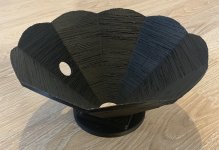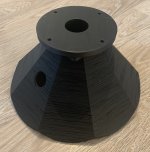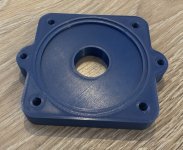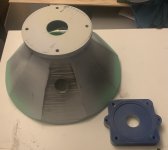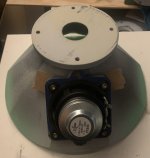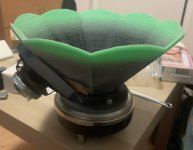Yesterday I was thinking about how to fit larger horn parts to my CNC and then I realized that if I use more sides than just 4, I can get a larger horn with the same axial length parts. I originally thought about 6 sides, but 9 seems to look really cool. It is now just a design study - 1" or 1.4" driver, 3 x 3 - 4" mids and 3 x 8 - 12" for lows. All will stay open backed (due to weight and ease of buiding) and maybe there will be even an ambience tweeter in the back. The diameter will be around 100 cm, depth around 60 cm with a coverage angle of 75 degrees (or somewhere between 60 - 90 degrees), I could not fit a larger one in any of my rooms anyway. Even this one will be hard to move through the doors.
I would like to do it "right", following all the MEH rules and do lots of simulations. At my normal indoor listening levels, these will be able to play down to 30 Hz (with EQ) even with open backs, there is plenty of subwoofers around the house that could be used if needed I see these in stained birch plywood (12 - 15 mm), prototype will be built from 16 mm chipboard.
I see these in stained birch plywood (12 - 15 mm), prototype will be built from 16 mm chipboard.
Should I really need a box, I could build one with 8 sides and fit a rectangular box around it with 4 (triangular) ports in the corners.


This design is constantly evolving. If anyone is interested in the 3D models and OpenSCAD scripts, send me a PM.
I would like to do it "right", following all the MEH rules and do lots of simulations. At my normal indoor listening levels, these will be able to play down to 30 Hz (with EQ) even with open backs, there is plenty of subwoofers around the house that could be used if needed
Should I really need a box, I could build one with 8 sides and fit a rectangular box around it with 4 (triangular) ports in the corners.
This design is constantly evolving. If anyone is interested in the 3D models and OpenSCAD scripts, send me a PM.
Last edited:
looks really cool I wonder could a bend be incorporated into a m.e.h to take up less floor space . like maybe pointing up to begin woth then bending round to face toward the listener. im sure theres a pro speaker company that does something similar with their hf drivers .where do you get your 16mm chipboard I've just made a prototype speaker with the same material leftover from a job . takes a screw well and sturdy enough for a trail run
First quick round of simulations in Hornresp was done. If I want to use the drivers I have available, I will start with a single 3FE22 and Sovereign 8-225 and the various 1.4" drivers since I have no suitable 1" driver at the moment. The advantage of the nine sided construction is that I have 9 sides for drilling holes in the prototype. Hornresp is showing some interesting results on the mids - if they are too close to the apex, there are some peaks and dips. I have never seen them in real life since my mids were never this close. I could also see some influence od the bass hole on the mid response if the ports were too close. Again, I am not sure I have ever placed the bass driver too close to the mids. What am I still not very comfortable with is the position of the bass entry holes with relation to the mouth - if that matters or not. It seems that there is some optimal placement which balances between the low end response and the cancellation notch. It seems I can get somewhere around low end 80 - 100 Hz cut off without too much EQ. I hope to be able to run them without subs with lots of volume. If that does not work out, I would like to figure out some nice layout with subwoofers. Something like sub carts by mark100, but smaller.
Bends are difficult to make (at least for me) and I somehow have a feeling that the large bent horns (like WE) have their own problems and the bends are not worth the effort. I have an issue with mouth size being too large, the depth is acceptable for me. I am getting the chipboard at a local hobby market - sometimes I also use the flooring panels if their size fits the purpose. 16 mm chipboard became my favourite material for prototypes, since it is easy to machine and cheap enough I have used it here https://www.diyaudio.com/community/...eter-faitalpro-3fe22-mids.400527/post-7385606 and here https://www.diyaudio.com/community/...h-1-4-cd-3d-print-and-cnc.383396/post-7269402
I have used it here https://www.diyaudio.com/community/...eter-faitalpro-3fe22-mids.400527/post-7385606 and here https://www.diyaudio.com/community/...h-1-4-cd-3d-print-and-cnc.383396/post-7269402
Bends are difficult to make (at least for me) and I somehow have a feeling that the large bent horns (like WE) have their own problems and the bends are not worth the effort. I have an issue with mouth size being too large, the depth is acceptable for me. I am getting the chipboard at a local hobby market - sometimes I also use the flooring panels if their size fits the purpose. 16 mm chipboard became my favourite material for prototypes, since it is easy to machine and cheap enough
Another round of simulations done. The 4NDF34 would be a better match in sensitivity to the Sovereign 8-225 (which is not surprising).
What worries me a bit is the connection of three woofers. Since all I have is 8 ohm variety, I would either need parallel connection and a resistor (half power wasted), series/parallel with one resistor instead of one woofer (1/4 power wasted, unbalance) or series connection (low voltage sensitivity). 4 or 16 ohm would be better...but that would mean buying new drivers.
Other options are going 8 sided (I like 9 sided more) and use two or four woofers. Or use the same on 9 sided with a slight asymmetry (might be actually a good thing?).
In the end, for home volumes, one mid and one woofer will be most probably good enough, keeping only the horizontal symmetry only does not sound bad to me - the yellow test horn above is using two 3" mids (or one 8" alternatively) and a single 18" and around 1 m away from the mouth, the polars (within coverage angles) start to look reasonable.
A box for the LF driver could form a stand for the horn - similar to these, but rectangular - wider, deeper and not as high, just to fit the woofer and maybe lift the horn a bit. https://www.diyaudio.com/community/...b23nrxs-point-source-horn.353508/post-6179942
Thinking out loud, a single 15" or 18" would be also play low with EQ.
Tomorrow, chipboard shopping
What worries me a bit is the connection of three woofers. Since all I have is 8 ohm variety, I would either need parallel connection and a resistor (half power wasted), series/parallel with one resistor instead of one woofer (1/4 power wasted, unbalance) or series connection (low voltage sensitivity). 4 or 16 ohm would be better...but that would mean buying new drivers.
Other options are going 8 sided (I like 9 sided more) and use two or four woofers. Or use the same on 9 sided with a slight asymmetry (might be actually a good thing?).
In the end, for home volumes, one mid and one woofer will be most probably good enough, keeping only the horizontal symmetry only does not sound bad to me - the yellow test horn above is using two 3" mids (or one 8" alternatively) and a single 18" and around 1 m away from the mouth, the polars (within coverage angles) start to look reasonable.
A box for the LF driver could form a stand for the horn - similar to these, but rectangular - wider, deeper and not as high, just to fit the woofer and maybe lift the horn a bit. https://www.diyaudio.com/community/...b23nrxs-point-source-horn.353508/post-6179942
Thinking out loud, a single 15" or 18" would be also play low with EQ.
Tomorrow, chipboard shopping
I am not brave enough for now to do twelve sides, I might try that later for a high SPL version. I hope I can get away with two mids and one larger woofer - that is what I am listening to right now on the right channel and I quite like it. The open back bass on the horn, boosted down to 30 Hz sounds really natural
I did another simulation - using 9 x Hadex Q311, which is a cheap 6.5 driver. I originally bought them for a SLOB project, but it looks they could work pretty well also here. The SD is an equivalent of 2 x 12" woofers and sensitivity is still higher than 4 3FE22 mids. I tried them in the large MEH prototype - they did work, but a pair was simply not enough. 9 pieces should be OK.
Here are the adapters to be printed to simulate the wall thickness. One with a plain hole, one frustumized and one with larger volume but a very short port (6 mm in total)

I have also tried to simulate 9 midranges in 3S3P connection and it seems that the Tymphany TC6FD02-4 is a pretty good match in sensitivity to the 3S3P connected Hadex woofers. That would be 19 drivers total per horn
This would be the simulated maximum SPL limited by the mids power with a slight touch of EQ:

It actually seems that with such small mids, I could easily use a 1" HF driver (if I can get them close enough together)
The other sensitivity matching option is 3 parallel connected BC 4NDF34 - but at almost double the price of the smaller mids. The advantage would be 10 dB more SPL with more power - which I would most probably never use anyway.
Hornresp is really great to play with the position of the entry holes - I cannot calculate the delay between drivers when using certain crossover filters, but Hornresp surely can and I am slowly getting to understand the various interaction between drivers and filters and their relative position on the MEH. If I can get it all right in real life, it will be an amazing speaker
I have also tried to simulate 9 midranges in 3S3P connection and it seems that the Tymphany TC6FD02-4 is a pretty good match in sensitivity to the 3S3P connected Hadex woofers. That would be 19 drivers total per horn
This would be the simulated maximum SPL limited by the mids power with a slight touch of EQ:
It actually seems that with such small mids, I could easily use a 1" HF driver (if I can get them close enough together)
The other sensitivity matching option is 3 parallel connected BC 4NDF34 - but at almost double the price of the smaller mids. The advantage would be 10 dB more SPL with more power - which I would most probably never use anyway.
Hornresp is really great to play with the position of the entry holes - I cannot calculate the delay between drivers when using certain crossover filters, but Hornresp surely can and I am slowly getting to understand the various interaction between drivers and filters and their relative position on the MEH. If I can get it all right in real life, it will be an amazing speaker
Another simulation shows that a pair of 3FE22s would be a good match as well at a cost of 2-3 dB max SPL and a slight vertical assymetry. Mounting to 2 of 9 surfaces, I think the mids holes could be offset a bit to create an almost perfect half circle, but it might be disturbing my OCD
Just for fun, I tried to simulate an open baffle with the radius of the horn depth . That comes in yellow. The green line is compound offset horn to simulate open back bass on the MEH and the blue one is MEH with a very large back chamber. All with 9 3S3P connected woofers. I do not know if compound offset horn (with a very short "back" horn) is the correct way of simulating the low section of a MEH with an open back, but it seems pretty legit to me. If I get something like the green curve, I will need around 8 dB boost to match the blue curve. The woofers can take 540 W compared to 40 W for a pair of 3FE22s (AES, peak is double the values). So there is plenty of headroom.

If my simulation is correct, it would imply that running the mids with open back would not influence the respose by dipole cancellation in the pass band.
If my simulation is correct, it would imply that running the mids with open back would not influence the respose by dipole cancellation in the pass band.
So the test horn with one mounting adaptor are printed. There was a catastrophic print failure on the horn and I have found out that the nozzle is partially clogged on my large printer The print is most probably unusable and I hope I have a spare nozzle...
The print is most probably unusable and I hope I have a spare nozzle...
Attachments
I am slightly confused. I measured the notch at 1510 Hz being an average from 4 measurements. The center of the mid hole is 65 mm above bug screen. The notch frequency corresponds to 57 mm, which is roughly the distance from the bug screen to the edge of the hole (coincidence?) Could it be that the acoustic center of the driver is at the bug screen or evem slightly above it? Will try BC DE72 later.
Hi pelanj
I have this theory, that the change in flare-rate from the inside of the CD to the much wider conical horn creates an invisible "reflection layer" at the throat of the horn, on wich the midranges (and woofer) reflect of and that this dictates the notch-frequency. It is still a theory, as I am not that far with my MEH to do any measurements to verify it.
Have you measured with a plate at the throat instead of a CD?
Steffen
I have this theory, that the change in flare-rate from the inside of the CD to the much wider conical horn creates an invisible "reflection layer" at the throat of the horn, on wich the midranges (and woofer) reflect of and that this dictates the notch-frequency. It is still a theory, as I am not that far with my MEH to do any measurements to verify it.
Have you measured with a plate at the throat instead of a CD?
Steffen
So it is confirmed. I need to search for the notch a bit due to the asymmetry. Without any driver, the frequency corresponds exactly to 1/4 wavelength of axial distance of the center of the hole. With the driver (shorted terminals), the frequency moves slightly up. I still may be doing something wrong in the measurements, but it is quite in agreement with the experience from my previous builds. Unfortunately, I have no good 1" driver, so I stay with the 1.4" throat for now.
Any recommendations for a 1" driver capable of 900 Hz crossover (just to have some reserve) with plastic diaphragm? Or titanium one with Mylar surround? I might sell the Beymas and get a 1" pair instead. 1.4" drivers are a bit under used with 3" mids. On the other hand, it would mean less distortion.
Any recommendations for a 1" driver capable of 900 Hz crossover (just to have some reserve) with plastic diaphragm? Or titanium one with Mylar surround? I might sell the Beymas and get a 1" pair instead. 1.4" drivers are a bit under used with 3" mids. On the other hand, it would mean less distortion.
I would try the BMS 4550. It has or is being used by Tom Danley in the SH50, and he has reported that it works very well with a conical horn/rapid opening due to a convex radiation-pattern at its exit.
https://www.bmsspeakers.com/index.php-104.html?id=bms_4550
https://www.bmsspeakers.com/index.php-104.html?id=bms_4550
4550
1" HIGH FREQUENCY COMPRESSION DRIVER
FEATURES :
- Unique patented Design
- 113 dB sensitivity 1 W / 1 m
- 800 Hz Crossover
- Extended high frequency response up to 20 kHz
- Small Size and low Weight
- 44.4 mm sandwich in- and outside VC
- 8 or 16 Ohm
There is also the BNS4552ND
https://www.bmsspeakers.com/index.php-362.html?id=4552nd_curves
It is a bit expensive at 253 € at TLHP
https://en.toutlehautparleur.com/compression-driver-bms-4552nd-8-ohm-1-inch-exit.html
The 4550 is only 141 €
https://en.toutlehautparleur.com/compression-driver-bms-4550-8-ohm-1-inch-exit.html
https://www.bmsspeakers.com/index.php-362.html?id=4552nd_curves
It is a bit expensive at 253 € at TLHP
https://en.toutlehautparleur.com/compression-driver-bms-4552nd-8-ohm-1-inch-exit.html
The 4550 is only 141 €
https://en.toutlehautparleur.com/compression-driver-bms-4550-8-ohm-1-inch-exit.html
4552ND
1" HIGH FREQUENCY NEODYMIUM COMPRESSION DRIVER
FEATURES :
- Unique Patented Design
- Neodymium Magnet Assembly
- 113 dB Sensitivity 1 W / 1 m
- 1 kHz Crossover
- Extended high Frequency Response up t 20 kHz
- Very small Size and low Weight
- 44.4 mm Sandwich in- and outside Voice Coil
- 8 or 16 Ohm
Last edited:
- Home
- Loudspeakers
- Multi-Way
- Nine-sided conical horn MEH
